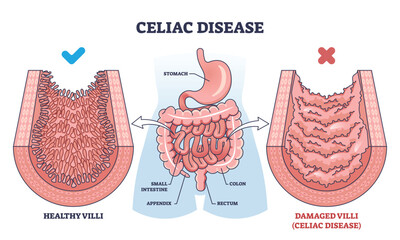
Inside our bodies is a complex universe full of microscopic structures that play an important part in our general health. The villi of the small intestine, for example, go unseen but play an important role in our digestive system. In this article, we explore the intriguing world of villi, learning about their role in nutrition absorption and how celiac disease may significantly affect their function.
The Small Intestine: The Nutrient Superhighway
The small intestine, while being only a tube-like organ, is a digestive and nutrient-absorption powerhouse. The majority of digestion and nutritional absorption from our meals occurs here. But how can the small intestine maximise its ability to absorb nutrients? The solution is found in the complicated structures known as villi.
Get to know the Villi.
Villi are microscopic, finger-like extensions that border the small intestine's walls. Though they appear little, they considerably enhance the surface area of the intestinal walls, allowing our bodies to absorb the nutrients required for survival. Consider the small intestine to be a huge, nutrient-rich field, with villi serving as the thick, dense grass that covers it.
The Role of Villi
Villi are not just there for show; they have a specific job to do. Their primary function is to increase the absorption of nutrients, such as carbohydrates, proteins, fats, vitamins, and minerals, from the partially digested food passing through the small intestine. They are equipped with even smaller hair-like structures called microvilli that further enhance their absorptive capacity.
Celiac Disease: An Immune System Attack
Now, let's turn our attention to celiac disease, a chronic autoimmune disorder that affects the small intestine and, consequently, the function of villi. In celiac disease, the body's immune system mistakenly targets and damages the villi in response to the consumption of gluten, a protein found in wheat, barley, and rye.
The Battle Within: Celiac Disease vs. Villi
In a person with celiac disease, the immune system's response to gluten causes inflammation and damage to the villi. Over time, these once-finger-like structures become blunted and flattened, dramatically reducing the surface area available for nutrient absorption. This can lead to malabsorption of nutrients, resulting in a range of symptoms, including diarrhea, abdominal pain, fatigue, and malnutrition.
Distinguishing Celiac Disease Villi from Normal Villi
The key difference between celiac disease villi and normal villi lies in their appearance and function. Normal villi are tall and densely packed, resembling a lush forest. In contrast, celiac disease villi are shorter, flattened, and often sparse, like a field of grass trampled by a storm.
Conclusion
Vili are the unsung heroes of the small intestine, quietly striving to ensure our bodies obtain the nutrients they require to operate properly. Understanding the impact of celiac disease on these critical structures emphasises the significance of early diagnosis and adherence to a gluten-free diet for people affected. The tale of villi in the small intestine is a monument to the wonders of the human body and the repercussions when things go wrong.

Comments